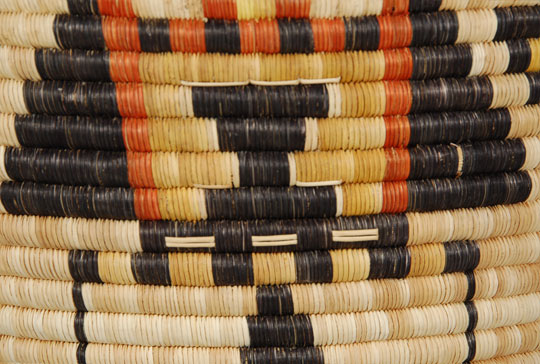Hopi Second Mesa Deep Pictorial Basket [SOLD]
+ Add to my watchlist Forward to Friend
- Category: Bowls and Other Forms
- Origin: Hopi Pueblo, Hopituh Shi-nu-mu
- Medium: yucca, grasses
- Size: 11-3/4” tall x 15-3/4” diameter
- Item # C3215F SOLD
The Hopi women of Second Mesa villages have been making coiled basketry for over a thousand years using the same materials and same techniques. None of the materials are from domesticated sources. They all are from wild plants. The leaf of the yucca plant is used for the weft design and grasses are bundled together for the warp foundation. The colors are limited to white, yellow, green, red and black. The first three colors are derived from the yucca leaves, the difference being in the time of year the material is collected. The rust and black colors are dyed yucca leaves.
The yucca leaves are split into narrow strips and used for coiling around the grass foundation. Each narrow strip is inserted into the previous row of stitches using an awl for making a tiny hole for insertion of the strip. This is done over and over as the design materializes.
This basket probably took over two months of daily work just to make, not counting the laborious time and effort to gather the materials and dye some of them. The design consists of full views of Crow Mother Katsinas and ears of corn. There are some imbricating stitches on the design elements. This basket is beautifully designed and executed and in very good condition. There are no more than two or three missing stitches and they are difficult to find.
The basket has a slight tilt but not enough to affect the visual appeal. This truly is a spectacular basket.
Provenance: from the Katherine H. Rust Collection
Recommended Reading: Hopi Basket Weaving: Artistry in Natural Fibers by Helga Teiwes

- Category: Bowls and Other Forms
- Origin: Hopi Pueblo, Hopituh Shi-nu-mu
- Medium: yucca, grasses
- Size: 11-3/4” tall x 15-3/4” diameter
- Item # C3215F SOLD



